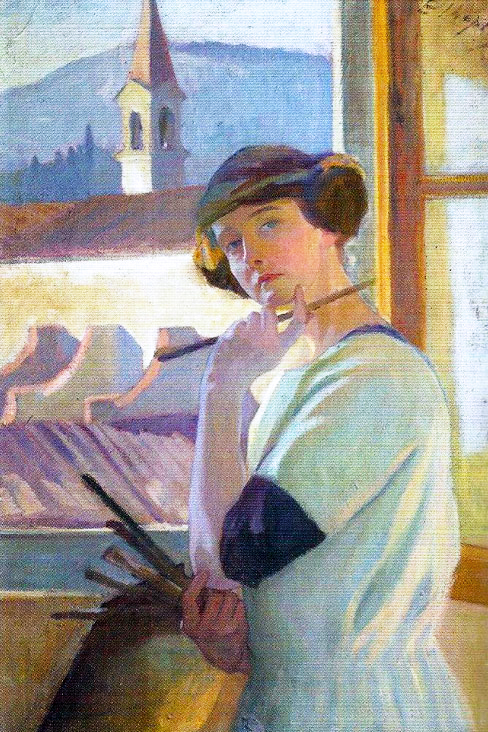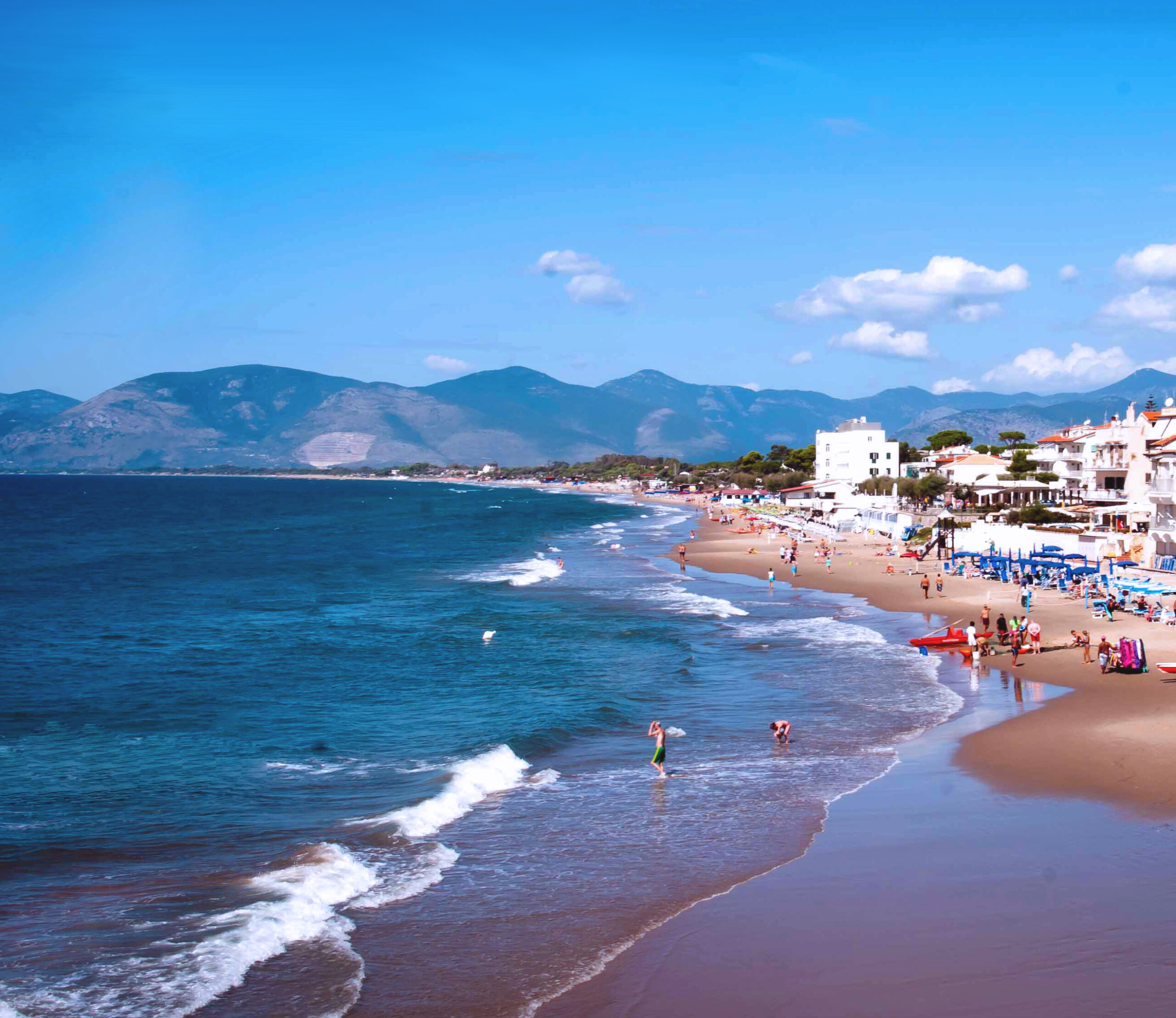The “Invisible Women of Florence”
In our fourth and final segment of this series, we examine Italian women who were primarily born in the 19th century. We have included one artist, Adriana Pincherle, who was born on 1905. As the trends and techniques of art evolved, so did the women of the 19th century. Examining the self-portraits of Louisa Grace Bartolini (1865) and Adriana Pincherle, painted a century later, illustrates the significant changes that occurred in texture, style, use of colors and composition.
We hope that you have enjoyed this series and have gained an appreciation for these remarkably talented “Invisible Women of Florence.”
Louisa Grace Bartolini
Louisa Grace Bartolini was born Louisa Grace in Bristol, England in 1818, into an Irish Catholic family of Italian descent. All four of the children were taught Italian. Her father was Sir William Grace, a baronet. In 1828, the family moved to Sorèze, where she completed her early studies in art and languages. Her first poems were written in Italian and French. She came to Tuscany in the late 1830s. In 1841, she moved to Pistoia. She contributed to various periodicals including La gioventù and La Rivista di Firenze. She also translated works by American and British contemporary poets into Italian. Bartolini’s salon attracted the top Italian intellectuals of her time, including Giosuè Carducci. In 1860, she married Francesco Bartolini, an engineer from Pistoia. Bartolini died in Pistoia in 1865 at the age of 47. Her artwork, which includes charcoal drawings, watercolors, oil paintings and manuscripts are held in the Biblioteca Marucelliana in Florence.
Beatrice Ancillotti Goretti
Beatrice Caterina Enrichetta Ancillotti Goretti was born in Florence in 1879 into a family of impassioned liberals. Her maternal grandfather, Demetrio Corgialegno, who had settled in Florence, fought alongside the poet Lord George Byron, during the Greek war of independence.
Beatrice’s father, Torello Ancillotti, met his wife through a friend who he had fought alongside under Giuseppe Garibaldi during Italy’s Third War of Independence. Awarded a silver medal for bravery during the conflict, when he returned to Florence he was employed by the National Library of Florence.
Following in her father’s footsteps, Beatrice attended the Accademia di Belle Arti in Florence before taking advanced classes at Giovanni Fattori’s school. She moved to Stellata, in the province of Ferrara, where she met Andrea Goretti. They married in Fiesole in 1904. This was the same year she painted her Self Portrait which is among the 170 watercolors, pastels and pencil drawings bequeathed by her only daughter, Maria Sara Goretti, to the Modern Art Collection.
During World War I, she worked as a nurse tending the wounded and the dying. In 1937, Goretti, aged 58, died in Pistoia.
Leonetta Cecchi Pieraccini
Born in Poggibonsi in 1882, Leonetta Pieraccini studied Fine Arts at the Scuola Libera del Nudo in Florence with Giovanni Fattori. She married art critic and literary scholar Emilio Cecchi in 1911 and the two moved to Rome, where they frequented the city’s literary and artistic circles. After her participation in the Secessione Romana exhibition in 1916, Cecchi became a leading exponent of the Roman school. Known for her ability to produce works that defied strict classification, she successfully presented her works in Italy, Europe and the U.S. During the 1930s and 40s, she exhibited works at the first Quadrennial in Rome and then in the Venice Biennials.
Although two of Cecchi’s oils, “Ballerina” and “Morning on the Hudson River” are part of the Pitti Palace’s modern collection, the Gabinetto Scientifico Letterario G.P. Vieusseux in Florence houses ten of her paintings, including portraits, still life and landscapes. Additionally, the library contains 21 watercolor drawings and 88 drawings in black pencil and ink.
Her second daughter, Giovanna (1914-2010), better known as Suso Cecchi D’Amico, was an important screenwriter for Italian cinema. Leonetta Cecchi Pieraccini died in Rome in 1977.
Élisabeth Chaplin
Élisabeth Chaplin came from a family of painters and sculptors. She was born in 1890 in France and moved with her family to Italy at the turn of the century. She took up painting while the family lived in Savona in Liguria. When the Chaplin family took up residence at the Villa Rossi in Fiesole, near Florence, in 1905, Elisabeth had the chance to visit Francesco Gioli’s studio and meet painter Giovanni Fattori. She also visited the Uffizi Museum regularly and enriched her learning by copying the classics. In 1910, her “Ritratto di Famiglia” (Family Portrait) won a gold medal from the Florence Society of Fine Arts (displayed in the Gallery of Modern Art, Florence).
In 1916, she moved with her family to Rome, where she would live until 1922. There she met Paul-Albert Besnard (1849-1934), a French painter and printmaker, who in 1913, was appointed Director of Villa Medici in Rome. He became one of Chaplin’s mentors. From 1922 to 1930s, Chaplin lived at Villa Il Treppiede in Fiesole and produced numerous portraits and frescoes. She socialized with painters Giovanni Fattori and Luigi and Francesco Gioli and art collector Bernard Bereson.
From the mid-1930s until the early 1950s, Chaplin lived in Paris. She received civil commissions for the École Professionelle of Metz, France and murals for Paris churches Notre-Dame-du Salut and Saint-Esprit. In 1937, she won a gold medal at the International Exhibition in Paris and in 1938, she was awarded the French Legion of Honor.
In 1946, the Uffizi Gallery acquired three of her paintings and requested a donation from the artist of her young “Self-portrait with a Green Umbrella” that now hangs in the Vasari Corridor.
She moved back to Villa Il Treppiede after the war and continued to paint landscapes and portraits and many family members and loved ones. Chaplin donated her entire body of works to Florence. Fifteen of her paintings are on show at Palazzo Pitti’s Modern Art Gallery, while almost 700 (paintings and sketches) are in storage. She died in Fiesole in 1982.
Adriana Pincherle
Adriana Pincherle was born in Rome in 1905. She came from an upper-middle-class family and from an early age, Adriana took a special interest in her father’s watercolors. After finishing her classical studies education, she enrolled in the Scuola Libera del Nudo at the Accademia di Belle Arti di Roma. There she met Mimmo Spadini and Scipione, who each helped her to make inroads into the Roman artistic environment. She made her artistic debut in 1931 in the group show “Prima mostra romana d’arte femminile” at the Galleria di Roma.
Adriana was particularly influenced by the Impressionist movement and the styles of the Fauves, Renoir and Matisse. She studied briefly in Paris and exhibited at numerous galleries. She returned to Italy in 1933 and met the painter Onofrio Martinelli, also a painter, in Genoa and the couple married in 1934 and settled in Florence. Between 1934 and 1940, Pincherle exhibited her work at different shows in Rome, Florence, Milan and Venice.
With the arrival of World War II and racial discrimination, Pincherle was forced to hide in small towns including Bibbiena, Vallombrosa and Taranto (her mother was Catholic, but her father was Jewish). During this time, she began to experiment with the technique of tempera painting, which uses a fast drying paint.
Adriana Pincherle showed a preference for portraiture. She admitted also that she enjoyed painting in tempera more than in oil. Furthermore, she preferred to mix different painting techniques. In her style, characterized by vibrant colors, you can recognize the influence of Scipione, as well the darting brushstrokes typical of Carlo Levi. She used numerous techniques as practiced by painters that influenced her, including those of the watercolors of her father.
Her husband died in 1966, but Pincherle continued to paint until the final days of her life, though she suffered memory loss. She died following a heart attack on January 8, 1996.





